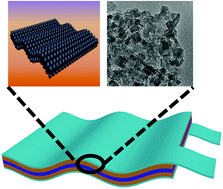Boosting solid-state flexible supercapacitors by employing tailored hierarchical carbon electrodes and a high-voltage organic gel electrolyte†
Abstract
Supercapacitors with high energy density and long cycle life without decay in the consecutive bending operation are urgently required for the next generation of wearable electronic devices. Here, we report a high-voltage flexible supercapacitor with enhanced energy density, which can be attributed to the tailored hierarchical carbon (HC) electrode materials and organic gel electrolyte. HC derived from MOF@graphene is synthesized via a facile and environmentally friendly process, where MOF derived porous carbon polyhedra are in situ anchored on the graphene surface to form a hierarchical nano-architecture. The HC shows a synergistic effect of porous nanocarbon and graphene, and possesses a large surface area (2837 m2 g−1), desired meso-/micropore distribution and superior conductivity. A 3.5 V solid-state flexible supercapacitor is constructed by employing HC electrodes and EMIMBF4/PVDF-HFP gel electrolyte, and it demonstrates a superior specific capacitance (201 F g−1) and good cycle life. The energy and power densities are significantly promoted (86 W h kg−1 at 438 W kg−1 and 61 W h kg−1 at 17 500 W kg−1). Meanwhile, the flexible supercapacitor shows excellent mechanical bending performance, exhibiting negligible capacitance decay under various bending states and repeated bending cycles, representing its promising potential for application in wearable electronics.



 Please wait while we load your content...
Please wait while we load your content...